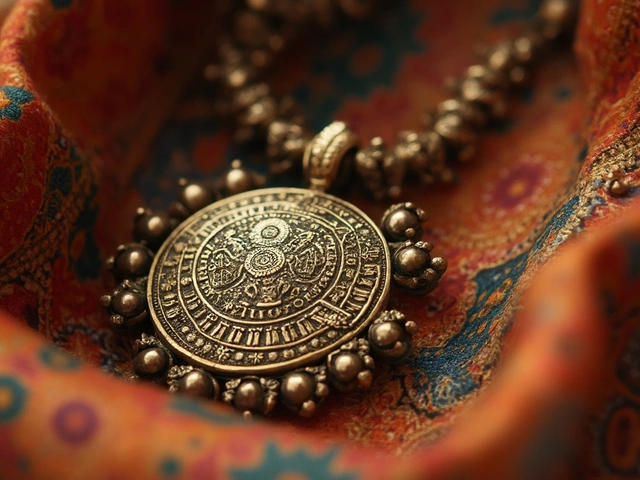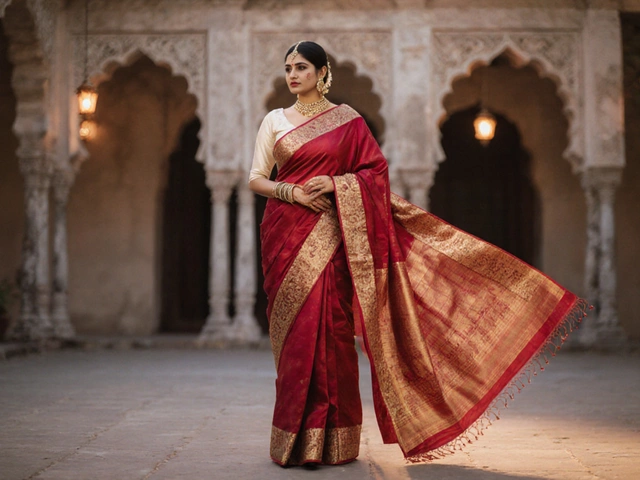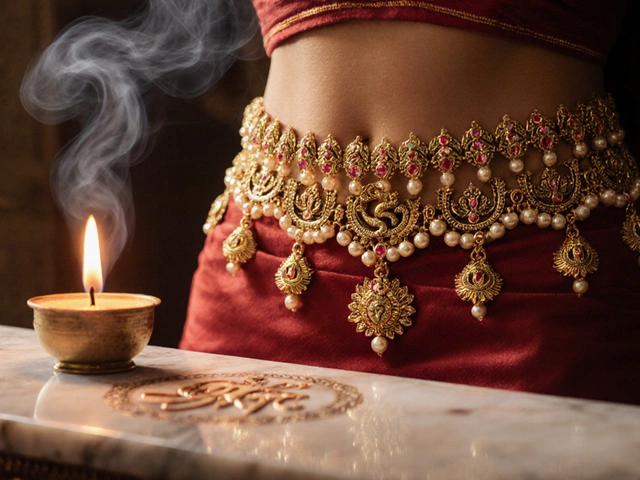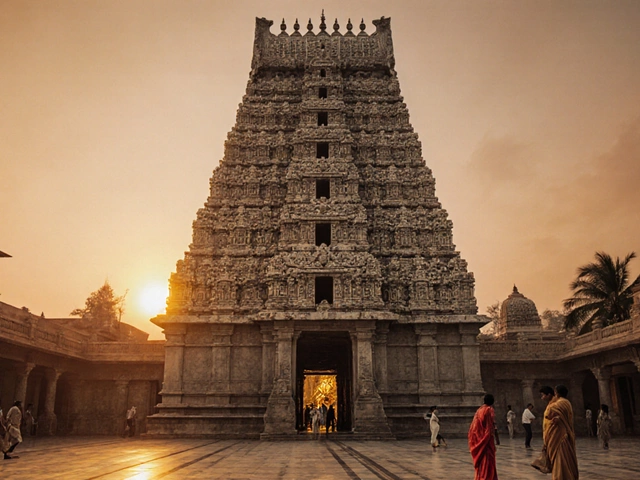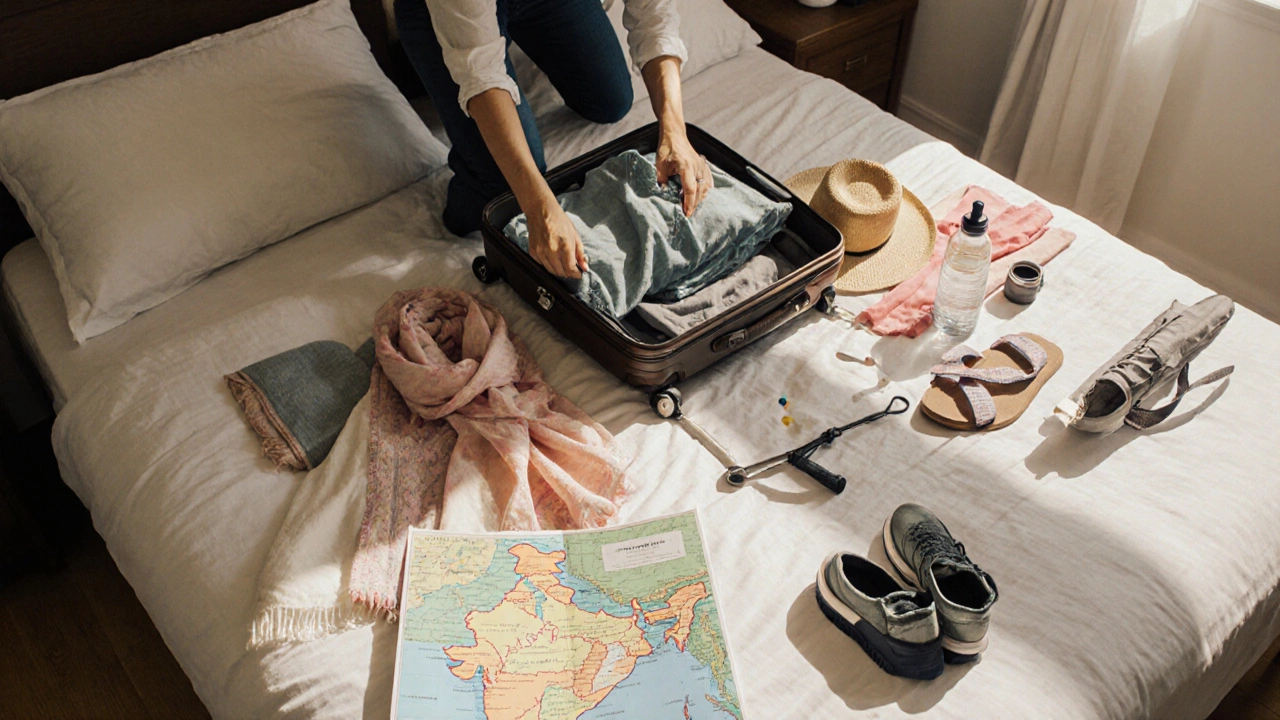
India Travel Packing Calculator
Plan Your Perfect Outfit
Get customized clothing recommendations based on your destination, season, and activities
Your Trip Details
Regional Guide
North India
Layer up; mornings can be cool, afternoons hot
Your Recommendations
Select your trip details and click "Get Recommendations" to see your personalized packing list.
Planning a trip to India and wondering what to pack? You’re not alone. The country’s sheer size means weather, culture, and customs shift dramatically from Delhi’s bustling streets to Kerala’s tropical backwaters. This guide breaks down the basics of tourist clothing India should consider, highlights must‑have accessories, and offers a quick‑run checklist so you can travel comfortably and respectfully.
Indian traditional clothing is a broad term that covers everything from the elegant sari to the relaxed kurta. While locals wear these garments daily, tourists can borrow a few style cues to blend in and enjoy a smoother experience, especially when visiting religious sites or rural areas.Why Dressing Right Matters
India’s climate ranges from scorching deserts to chilly mountain passes. Wearing the wrong fabrics can leave you sweating in Rajasthan or shivering in Shimla. Beyond comfort, modesty matters. Many temples, mosques, and even upscale hotels have dress codes that require covered shoulders and knees. Ignoring these norms can lead to denied entry or unwanted attention.
Regional Dress Snapshot
Below is a quick look at what most tourists wear in four major zones. Think of it as a cheat sheet for deciding what to pull from your suitcase each day.
| Region | Typical Garment | Climate Tips | Recommended Accessories |
|---|---|---|---|
| North (Delhi, Rajasthan, Himachal) | Lightweight kurta with cotton trousers or linen shalwar | Layer up; mornings can be cool, afternoons hot | Pashmina shawl, sun‑hat, comfortable sandals |
| South (Kerala, Tamil Nadu) | Loose cotton shirt with drawstring pants (lungi) or airy maxi dress | Breathable fabrics, quick‑dry; expect humidity | Water‑resistant tote, flip‑flops, minimal jewelry |
| East (Bengal, Odisha) | Soft cotton kurti paired with leggings | Monsoon season brings rain; carry a light rain jacket | Umbrella, waterproof sandals, simple bindi for fun |
| West (Mumbai, Gujarat) | Smart casual - polo shirt and chinos or a casual dress | Coastal humidity; breathable blends work best | Straw hat, sunglasses, low‑profile watch |
Key Clothing Pieces for Tourists
- Kurta: A long, loose‑fitting shirt that pairs well with jeans or traditional pants. Cotton or linen keeps you cool.
- Sari (optional): If you’re feeling adventurous, renting a pre‑stitched sari for a night out is a fun cultural experience.
- Salwar Kameez: A comfortable two‑piece outfit, perfect for temple visits because it covers shoulders and knees.
- Lightweight trousers or jeans: Choose stretchy denim for long travel days.
- Maxi dress or tunic: Ideal for women, offering coverage and airflow.

Essential Accessories
Accessories not only elevate your look but also address practical needs like sun protection and modesty.
- Pashmina shawl - A versatile wrap for chilly evenings and temple modesty.
- Sun hat or cap - Shields face from intense UV in desert areas.
- Lightweight scarf - Can double as a head covering in sacred sites.
- Comfortable walking shoes - Sneakers with good grip are a lifesaver on uneven streets.
- Flip‑flops or sandals - Easy to slip off before entering homes or shrines.
- Minimal jewelry - Simple studs or a thin chain avoid snagging on fabrics.
Do’s and Don’ts for Indian Travel Dress
Quick rules of thumb keep you safe and respectful.
- Do wear clothing that covers shoulders and knees when entering temples, mosques, or rural villages.
- Do choose breathable natural fibers - cotton, linen, and bamboo are gold standard.
- Do carry a small reusable bag for laundry; many hostels provide washing stations.
- Don’t wear revealing outfits like tank tops or short shorts in conservative areas.
- Don’t bring heavy leather shoes; they become uncomfortable in heat and rain.
- Don’t forget a rain jacket during monsoon months (June‑September).
Sample Packing Checklist
- 2-3 lightweight cotton kurtas or shirts
- 1 pair of stretchy jeans or travel pants
- 2 breathable dresses or maxi skirts (for women)
- 1 pashmina or shawl
- 1 pair of comfortable sneakers
- 1 pair of flip‑flops
- Sun hat, sunglasses, sunscreen (SPF30+)
- Small umbrella or packable raincoat
- Minimal jewelry (stud earrings, simple chain)
- Reusable water bottle and a lightweight daypack

Special Situations: Festivals and Rural Travel
India’s festivals are a visual feast, but they also come with dress etiquette. During Holi, white cotton clothes are ideal because the colors will stain any fabric. In desert festivals like Pushkar Camel Fair, a loose kurta and a sturdy pair of boots protect against sand.
If you venture into villages in states likeMadhya Pradesh orOdisha, consider wearing a modest kurti with long trousers. Locals appreciate the effort, and you’ll blend in while exploring markets or homestays.
How to Shop for Local Clothing On‑the‑Go
One of the joys of traveling in India is picking up a hand‑embroidered shirt or a silk scarf from a market stall. Here’s a quick tip: always ask for a “price check” and be ready to negotiate. Vendors expect a little bargaining; start at half the displayed price and work up. If you’re unsure about fit, most tailors in cities like Jaipur will stitch a quick alteration for a few rupees.
Frequently Asked Questions
What should I wear when visiting a Hindu temple?
Cover your shoulders and knees. A long kurta, a salwar kameez, or a lightweight dress with a shawl works perfectly. Remove shoes before entering the sanctum.
Is it okay to wear a T‑shirt and shorts in big cities?
In metros like Delhi, Mumbai, and Bangalore you’ll see many tourists in T‑shirts and shorts, especially in nightlife areas. Just remember to add a light scarf or shawl if you plan to visit a religious site.
Do I need to bring a raincoat for the monsoon?
Yes, if you travel between June and September. A packable rain jacket or a small umbrella fits easily in a day‑pack and keeps you dry during sudden downpours.
Can I wear jewelry while touring?
Simple pieces are fine, but avoid large, dangling earrings or heavy bangles that could snag on fabrics or get lost in crowds.
What footwear is best for Indian streets?
A pair of sturdy, breathable sneakers works for city walking, while flip‑flops are handy for beach towns and for removing before entering homes or temples.
Should I bring a scarf for women?
A lightweight scarf is a smart addition. It can double as a head covering in holy sites and protect you from dust in desert areas.


